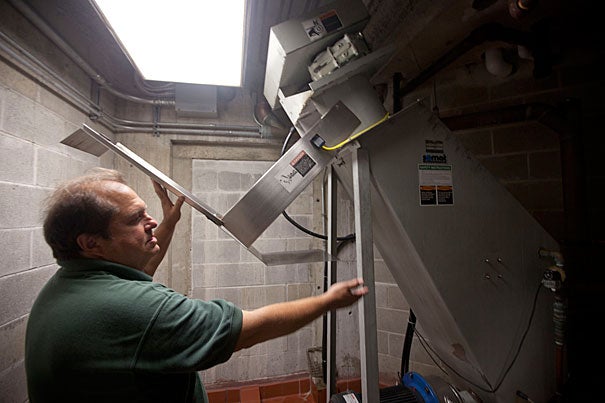
Bob Leandro shows how the composting machine and water-reduction sinks work inside the kitchen at Dunster House. Such upgrades brought Harvard LEED recognition.
A green building milestone
Harvard celebrates completion of 50th LEED-certified project
Ask one of the millions of tourists who flock to Harvard Yard each year to describe the University’s campus, and chances are you’ll hear the word “historic.” In the world of green construction, however, Harvard’s storied old buildings are positively cutting edge.
That’s in no small part due to the University’s commitment to building and renovating with an eye toward sustainability, a goal driven home by a recent milestone. As of this week, Harvard became the first higher education institution to complete 50 Leadership in Energy and Environmental Design (LEED) certifications for construction projects around campus, a process 10 years in the making.
The 50 projects represent a broad commitment to the Green Building Standards that Harvard adopted in 2009. The University’s green building projects cover 1.5 million square feet, with another 3 million in the works. (That dedication also runs deep. The geothermal wells that help heat and cool Byerly Hall reach 1,500 feet underground, undetected by passersby on the Radcliffe Quad.)
Forty more LEED projects are being conceptualized and built, with the help of Harvard’s central Office for Sustainability and the Campus Services Green Building Services Team, which consults with various Schools and departments on its green construction projects.
The milestone wouldn’t be possible without the effort of staff members across Harvard, who helped the University to lead by example in sustainable building practices, said Harvard President Drew Faust.
“As a university, we have a special responsibility to confront the challenges of climate change not only through academic research but by transforming the way we operate our campus,” Faust said.
Harvard’s contribution to green-building culture goes well beyond hitting the new milestone, said Kristin Simmons, higher education associate for the U.S. Green Building Council, which sets LEED guidelines.
“Sustainability at Harvard is comprehensive in that it really has taken an approach of institutional change, and not just doing things for ‘eco-bling,’ or the wow factor,” Simmons said.
The University has also led the way in sharing information and best practices on green.harvard.edu, she said.
“We’ve had a number of institutions that’ve told us it’s so helpful to see what [Harvard has] done,” Simmons said. “The case studies … made publicly available online are really unique within higher education, and in fact within green building in any sector.”
Living up to LEED standards involves more than just the cut-glass “LEED Certified” plaque a building gets to hang on its wall. Outreach to the faculty, staff, and students who occupy Harvard’s buildings — whether to ask for input at the start of a project, or to educate them on how to lower their energy consumption once they move into a new space — is critical, said Heather Henriksen, director of the Office for Sustainability.
“I really think we have a culture here, driven by the students, that embraces sustainability and that really helps all the people who work on this issue to be effective,” Henriksen said.
But the occupants benefit from lowering energy use and building costs, too. Just ask the residents of the fourth floor of Holyoke Center, now an oasis of natural light, natural wood, and open space in the otherwise unremarkable-looking concrete building.
“Prior to this I was sharing a basement office with no windows,” said Ellen Hart, administrative manager for the Faculty of Arts and Sciences Advising Programs Office (APO), which moved to the space in August 2009 after its LEED-certified renovation. “It was basically a closet.”
“It’s nice because we do work together a lot, and I can just hop over to ask someone a question if I need to,” her colleague Rafael Quintanar, a management fellow in APO, added. “There’s so much flow to the space.”
Proponents argue that green building makes good sense for an institution like Harvard. Colleges and universities tend to be innovators when it comes to sustainable construction, Simmons said, adding that institutions of higher education have the highest percentage of LEED-certified space per square foot of any sector in America. Unlike most private companies, universities own and operate their own space rather than leasing it.
“In the commercial market, people buy and sell buildings really quickly,” Simmons said. “They don’t necessarily get the benefits of building well or choosing highly efficient options, so they’ll do what’s easiest and cheapest. Universities know that in 10 years, even in 100 years, it’s still going to be their building,” she added. “They’re going to reap the benefits of efficient and healthy buildings.”
Share this article
LEEDing the way
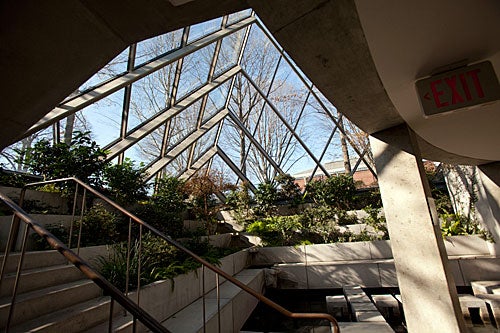
Stay gold
The HBS Class of 1959 Memorial Chapel is Harvard’s first LEED for Existing Building: Operations and Maintenance Gold certification. Since September 2008, the chapel has reduced its energy consumption by 49 percent. Kris Snibbe/Harvard Staff Photographer
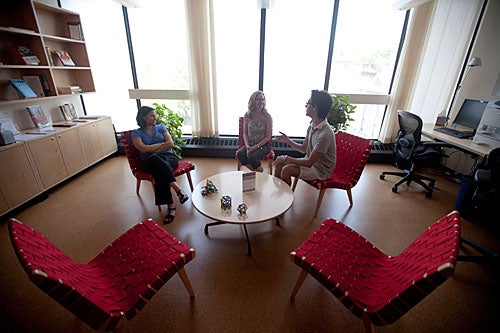
Letting the sun shine in
LEED green building projects not only help reduce energy use — they also create healthier, more welcoming places to work, live, and learn. The 2009 renovation of Holyoke Center’s fourth floor created conference room space and maximized daylight. Only low- or zero-VOC materials were used during construction. Kris Snibbe/Harvard Staff Photographer
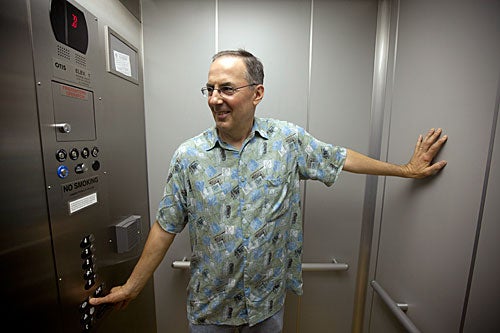
The lift gets a lift
Ralph DeFlorio, Harvard Divinity School’s director of operations, views a regenerative elevator inside Rockefeller Hall. The hall is included in a tour of LEED-certified buildings at Harvard University. Kris Snibbe/Harvard Staff Photographer
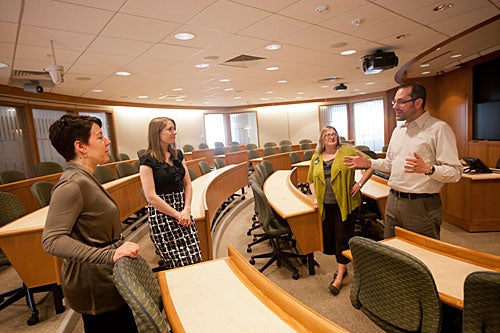
A world first
The renovation of HGSE’s Larsen Hall First Floor classroom made it the first LEED-CI Platinum certified classroom in the world. Efficient lamps and fixtures with pre-set lighting scenes have helped reduced electricity use by an estimated 45 percent. Brooks Canaday/Harvard Staff Photographer
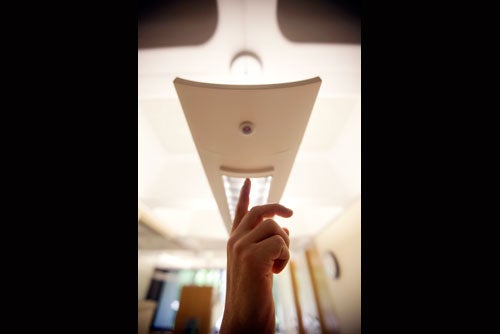
Lighting solutions, guilt-free
SEAS’s first LEED certification project incorporated energy efficient lighting fixtures and more accessibility to daylight in the core areas of the office. The renovation included a nine-day “flush-out” to ensure the building’s air was free of contaminants from the construction, making the space healthier for employees. Kris Snibbe/Harvard Staff Photographer
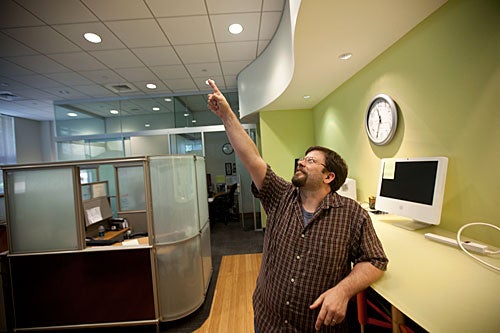
Thermodynamic
Benjamin Gerber, info tech support associate at Harvard’s School of Engineering and Applied Sciences, shows off the IT office’s renovations, which feature sensors that adjust the thermostat when the office is unoccupied. Kris Snibbe/Harvard Staff Photographer
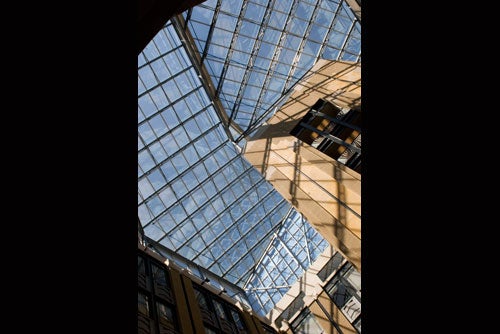
A Landmark landmark
The 2001 renovation of 42,000 square feet of space in Landmark Center became Harvard’s first LEED-certified project. More than 75 percent of workspaces have access to daylight and views, and the site now has efficient lighting systems and renewable bamboo floors. Rose Lincoln/Harvard Staff Photographer
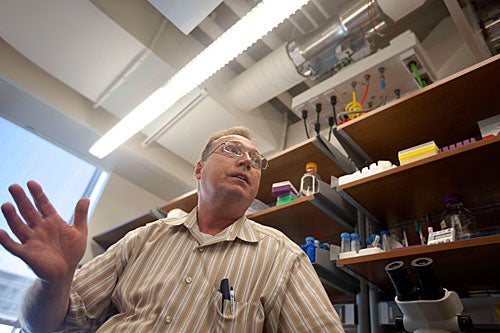
Heads above the rest
Harvard’s 50th LEED-certified building project in the Northwest Building, the Faculty of Arts and Sciences Zhang/Center for Brain Science Lab, optimizes daylight and views and uses occupancy sensors to control lighting. A new ventilation system maximizes energy efficiency, adjusting temperature, airflow, and ventilation based on occupancy. Kris Snibbe/Harvard Staff Photographer
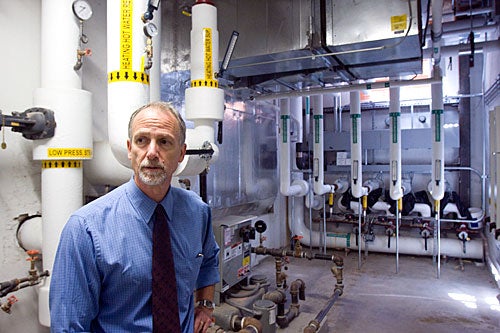
Hot and cold
Who says historic preservation and cutting-edge sustainable design can’t go hand in hand? The complete renovation of Byerly Hall includes ground-source geothermal heat pumps, dug 1,500 feet into the earth, that heat and cool the building. The wells are 44-percent more efficient than conventional mechanical systems. Kris Snibbe/Harvard Staff Photographer
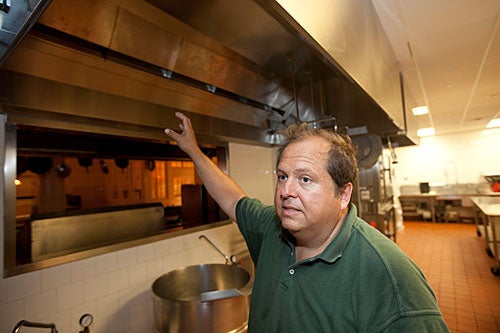
Don’t hate — ventilate!
Mather/Dunster became the nation’s first LEED-CI kitchen in 2006. The kitchen now features a composting machine, high-efficiency dishwashers, self-adjusting Melink exhaust hoods to ventilate cooking smoke, and a dish return that uses recycled gray water from the kitchen’s food grinder. Kris Snibbe/Harvard Staff Photographer
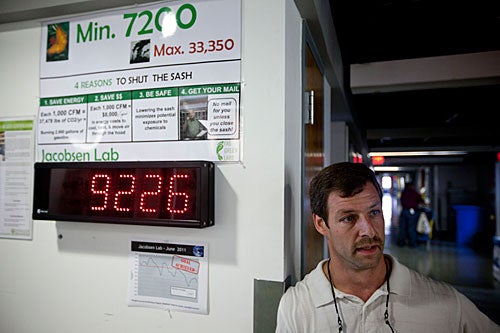
Fuming
A complete renovation of this organic chemistry lab in 2010 included state-of-the-art fume hoods with real-time exhaust monitors, which allow researchers to track their energy use. A competition run by the Office for Sustainability and the FAS Green Program encourages labs to reduce energy consumption by closing fume hoods when not in use. Kris Snibbe/Harvard Staff Photographer
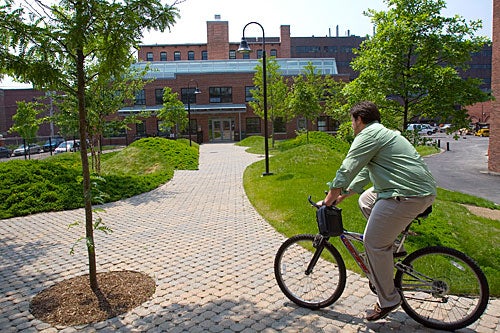
Movin’ on up
The renovation of the 46 Blackstone complex, a former industrial site, was the University’s first LEED Platinum-certified project and one of its most ambitious undertakings to date. The brownfield project includes several on-site strategies to minimize pollution runoff to the Charles River, including a bioswale system that naturally filters stormwater runoff from an adjacent parking lot. Kris Snibbe/Harvard Staff Photographer




